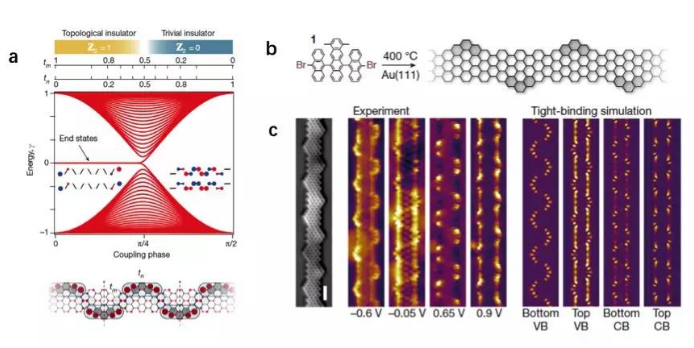On August 9th, the top international academic journal Nature reported on the topic of "Engineering of robust topological quantum phases in graphene nanoribbons". Wang Shiyong, Special Research Fellow, School of Physics and Astronomy, Shanghai Jiaotong University, and Roman Research Group, Swiss Federal Institute of Materials Science and Technology, Germany The latest results of the collaboration between the Klaus Mullen team at Maple, the Vincent Muller team at Rensselaer Polytechnic University, and the Feng Xinliang team at Dresden University of Technology in Germany. Following the acquisition of atomic-scale precision sawtooth graphene nanoribbons in 2016 (Nature 531, 489, 2016), they made another breakthrough to synthesize graphene nanoribbons with topological properties for the first time. Oliver Groning of the Swiss Federal Laboratory, Wang Shiyong of Shanghai Jiaotong University, and Yao Xuelin of Max Planck, Germany, are the co-first authors of the article. This work was also featured in the highlights of Nature news and views (Nature 560, 175-176, 2018; Nature 560, 209-213, 2018).

a SSH model in graphene nanoribbons; b surface chemical synthesis method to obtain atomic-scale graphene nanoribbons; c graphene nanoribbons structure and electrical properties
Graphene nanobelts are quasi-one-dimensional graphene nanostructures. Due to quantum confinement effects and boundary effects, their electronic structures are closely related to their width and edge structure. Theoretical studies have shown that graphene nanoribbons with an armchair-shaped edge structure exhibit semiconductivity, and their band gap increases with the decrease of nanoribbon width; while graphene nanoribbons with zigzag edge structure exhibit spin polarization characteristics. . It is particularly peculiar that graphene nanoribbons with specific irregular edges have novel topological properties. In 2017, the Steven Louie Group of the University of Berkeley predicted that the graphene nanoribbon structure with alternating edge structure has a topologically protected interface state, which can be used to control the one-dimensional topological quantum state and implement the Su-Schrieffer-Heeger model (Fig. a).
Although theoretical studies have shown that graphene nanoribbons can exhibit a series of singular electrical, magnetic, and topological properties, due to the difficulty in sample preparation, especially the width and edge structure of nanobelts are difficult to accurately control, there are great reports in different experiments. Deviation, so far only a few theoretical predictions have been confirmed by deterministic experiments. In recent years, the development of surface chemical synthesis methods has enabled the controlled growth of low-dimensional organic nanomaterials [Nature 466, 470, 2010]. Based on the "bottom-up" surface synthesis pathway, by selecting different molecular precursors, precise adjustment of the width, shape and doping of the nanostructures can be achieved, and the graphene nanostructures with precise atomic level can be realized. Combined with surface methods such as non-contact atomic force microscopy, scanning tunneling microscopy, and scanning tunneling differential spectroscopy, surface chemical synthesis provides a new platform for studying some polymer systems that were previously difficult to study by traditional chemical methods and can be characterized at a single chemical bond scale. Structural, chemical and physical properties of related materials. As shown in Figure 1, they accurately synthesized the molecular precursors and synthesized graphene nanoribbons with alternating widths on the surface of Au(111) (Fig. b). The ultra-high resolution AFM imaging technique determines the chemical structure of the synthesized nanobelts and verifies that the relevant synthesis methods are highly controllable. The scanning tunneling differential spectroscopy technique determines the topological properties of graphene nanoribbons, and the correlation results are highly consistent with the theory (Fig. c). By changing the molecular precursors, they realized the precise regulation of the topological properties, realized the graphene nanoribbons with non-mean topology, and observed the topological end states of the ends of graphene nanoribbons.
The work has been highly recognized by Nature's reviewers: this work is highly original, exciting, and has great significance in different fields (I find the manuscript to be highly original, exciting and of great significance to people in various Discipline.); Relevant research is very meaningful. Implementing topological quantum states in nanobelts provides a very interesting platform for studying the topological structure (The study is highly interesting and the realization of topological states in GNRs could provide an interesting playground). For further exploring topological structures in networks.).
Handmade Apron Kitchen Sink,Kitchen Sink,Stainless Handmade Apron Farmhouse,Handmade Apron Farmhouse Kitchen Sink
Guangdong Huayou Hardware Products Co.,Ltd , https://www.gudsink.com